Abstract
Primary anti-influenza A cytotoxic thymus-derived (T) and bone marrow (B) lymphocyte-dependent responses in inbred mice were used as an in vivo model system to study the effects of the immunosuppressive fungus metabolite cyclosporin A (CyA). Five consecutive daily oral applications of CyA, with the first being given 1 or 2 h before virus inoculation of the animals, caused a complete blockage of induction of anti-influenza T killer cells and a partial reduction of cytotoxic B lymphocyte activities. Adoptive cell transfer experiments revealed that incapability to respond was due neither to humoral factors nor to the generation of suppressor cells. The tolerance state appeared to be specific for influenza A; cytotoxic T lymphocytes against allogeneic cell surface determinants could be stimulated in immunosuppressed mice. CyA treatment abolished virus-specific and cross-reactive anti-influenza killer T cell responses. Suppression was of short duration: less than 1 week for B cell-dependent functions, and between 1 and 2 weeks for T killer cell responses. Animals appeared to be normal with regard to both of these cellular activities for 4 weeks after tolerance induction. Thus, the data indicate that CyA exerted preferential effects on killer T cells. Moreover, evidence was presented that CyA treatment during an ongoing influenza infection did not increase sensitivity to that virus. Mice with no measurable cytolytic anti-influenza T killer cell activities but significant B cell responses, although partially diminished by the drug, were completely protected against the lethal effects of influenza infection.
Full text
PDF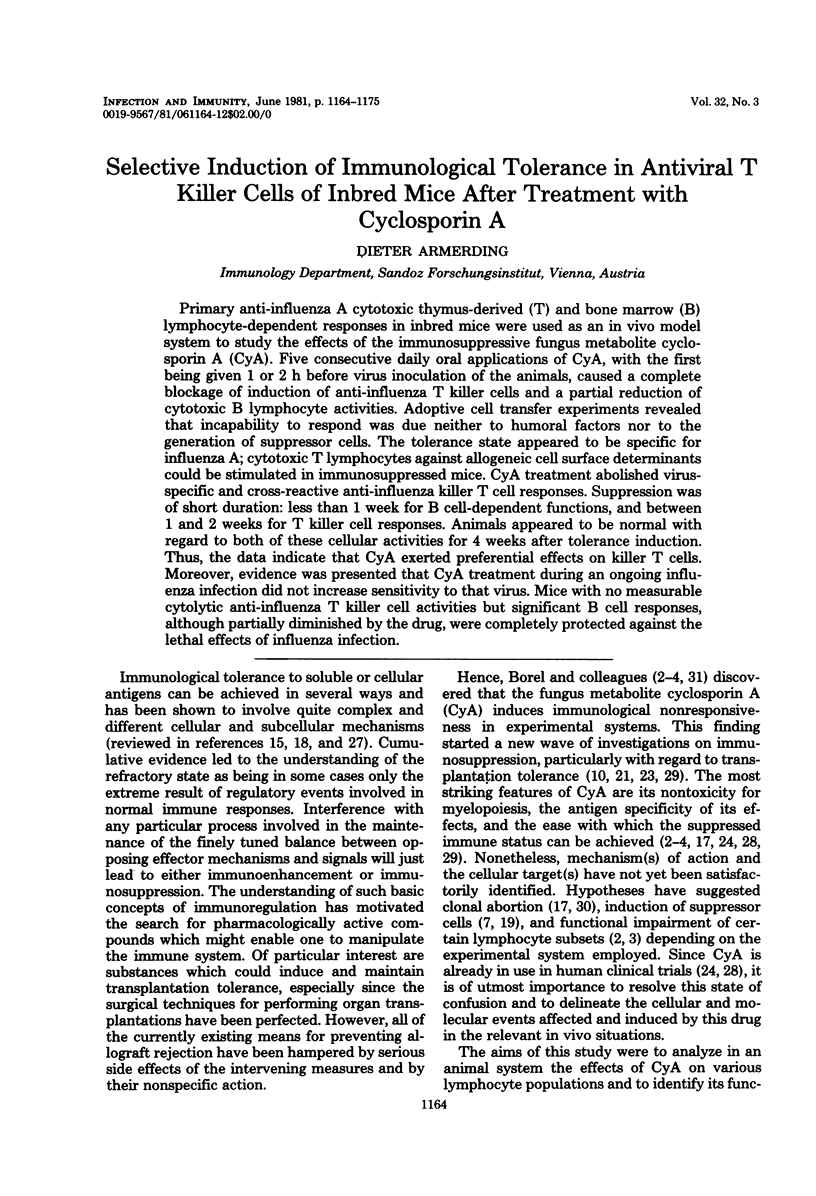

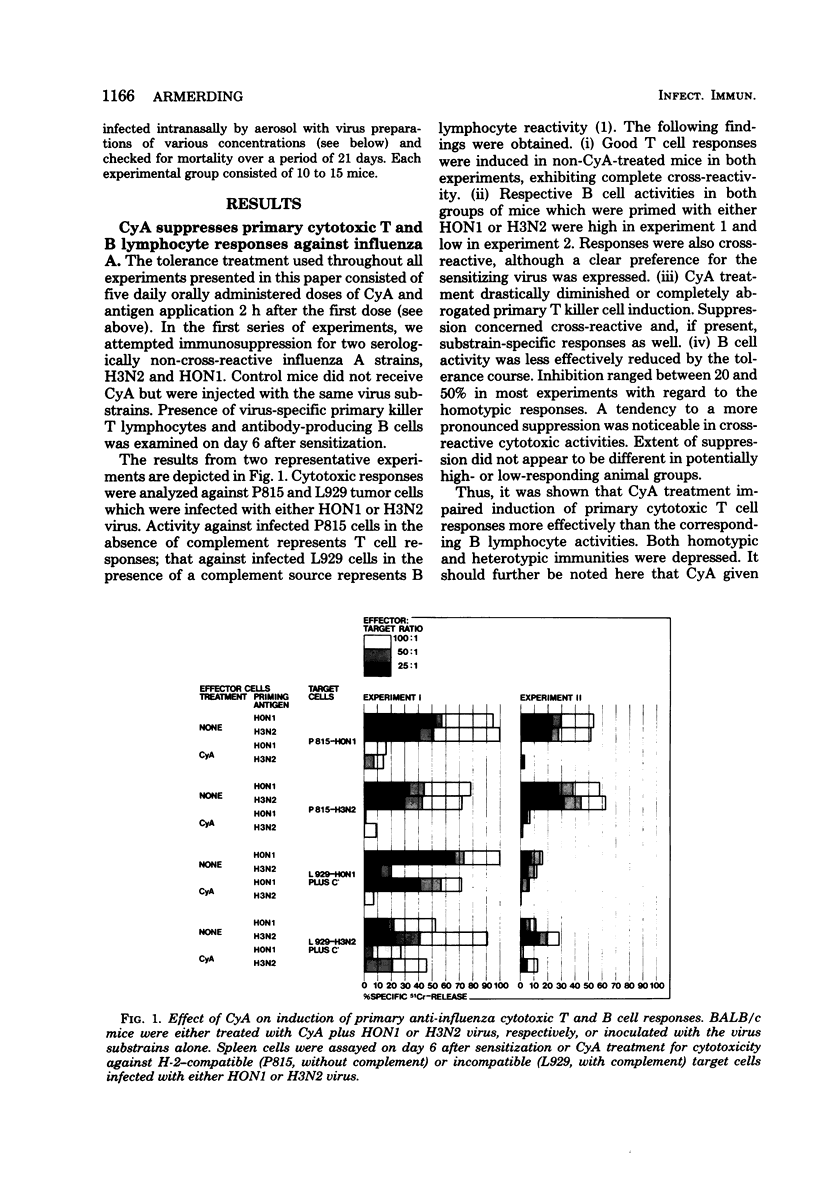

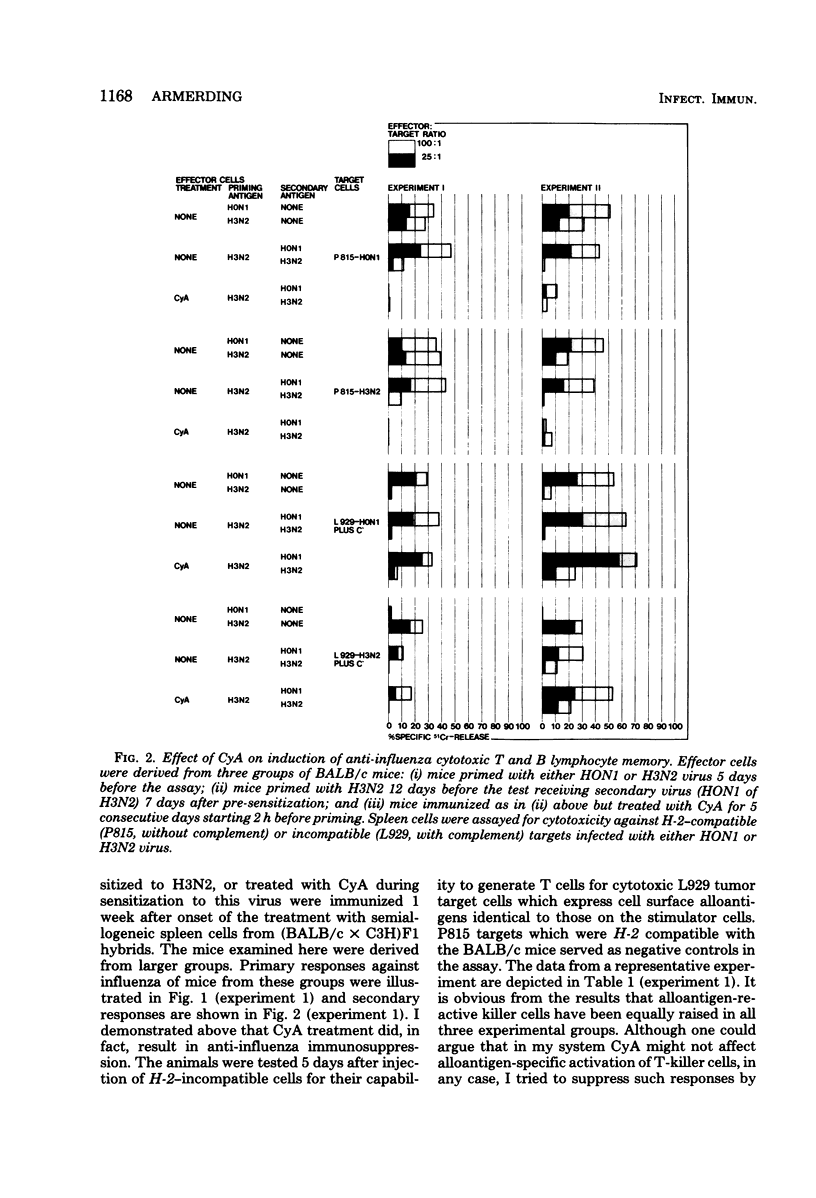

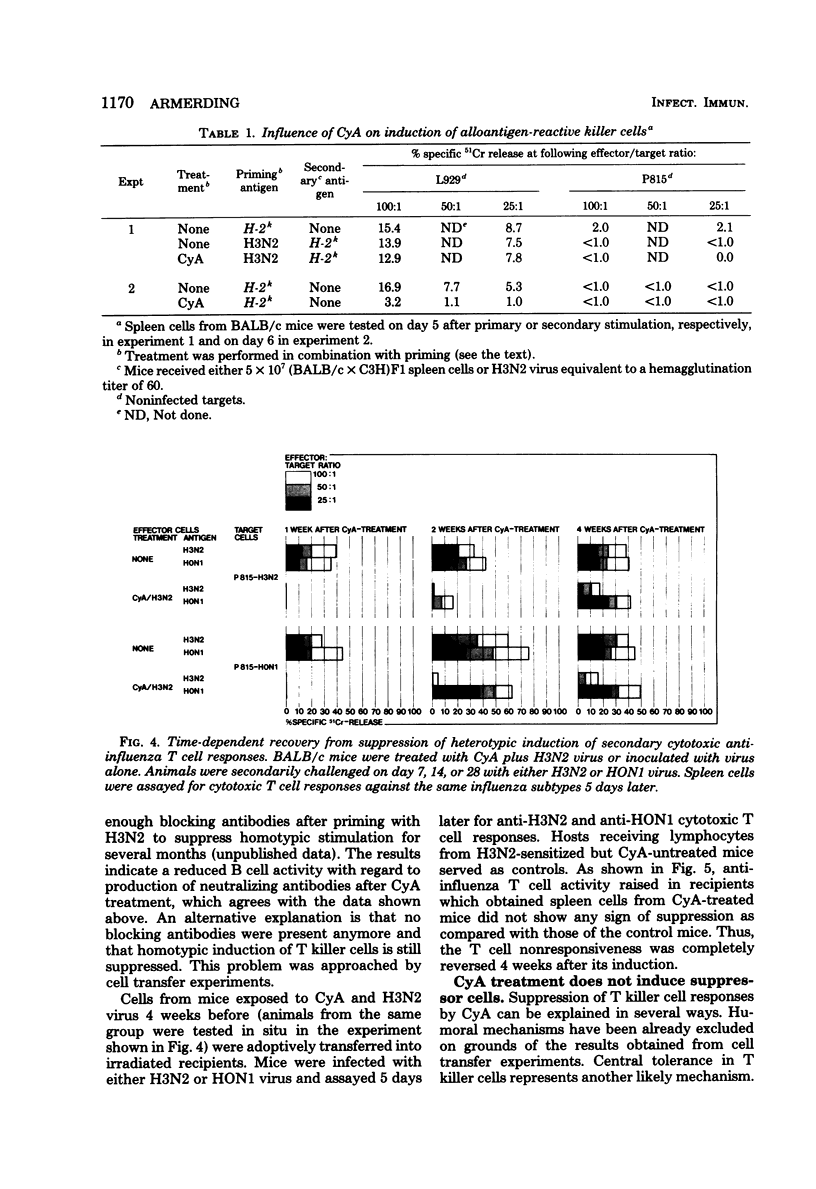
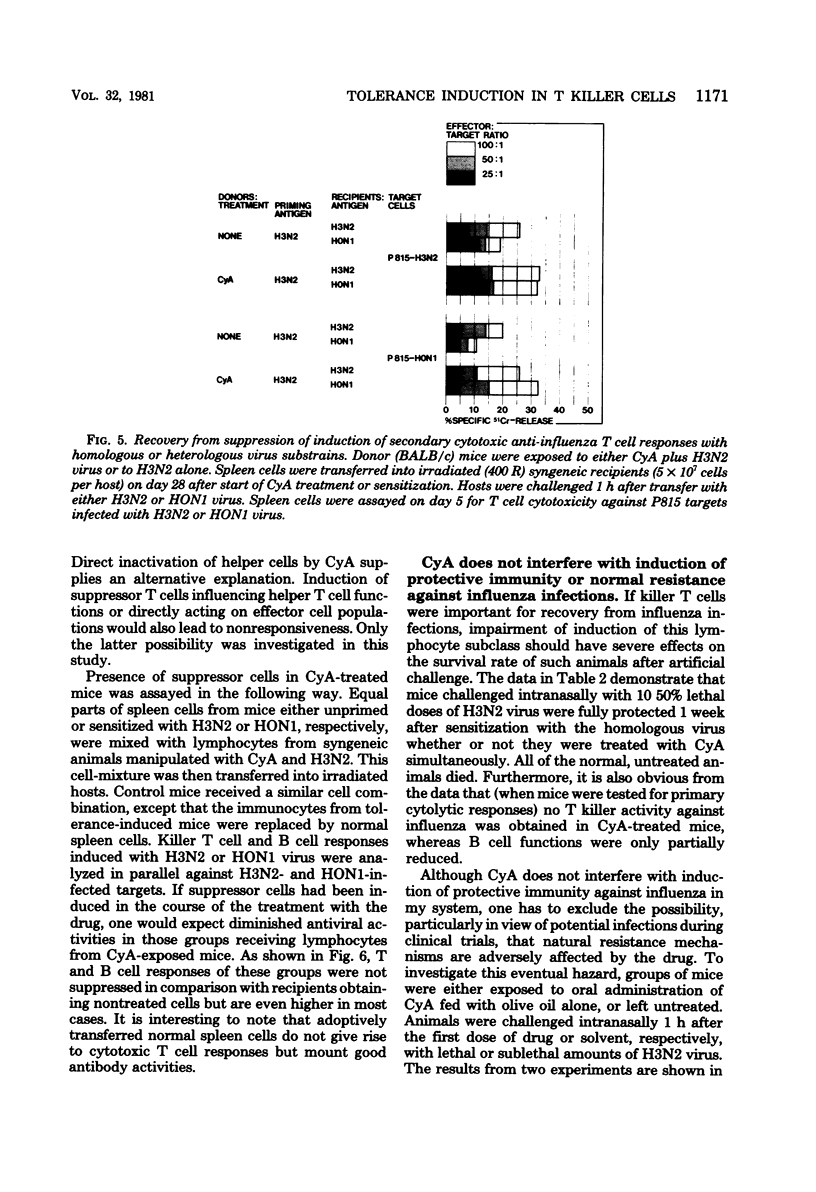

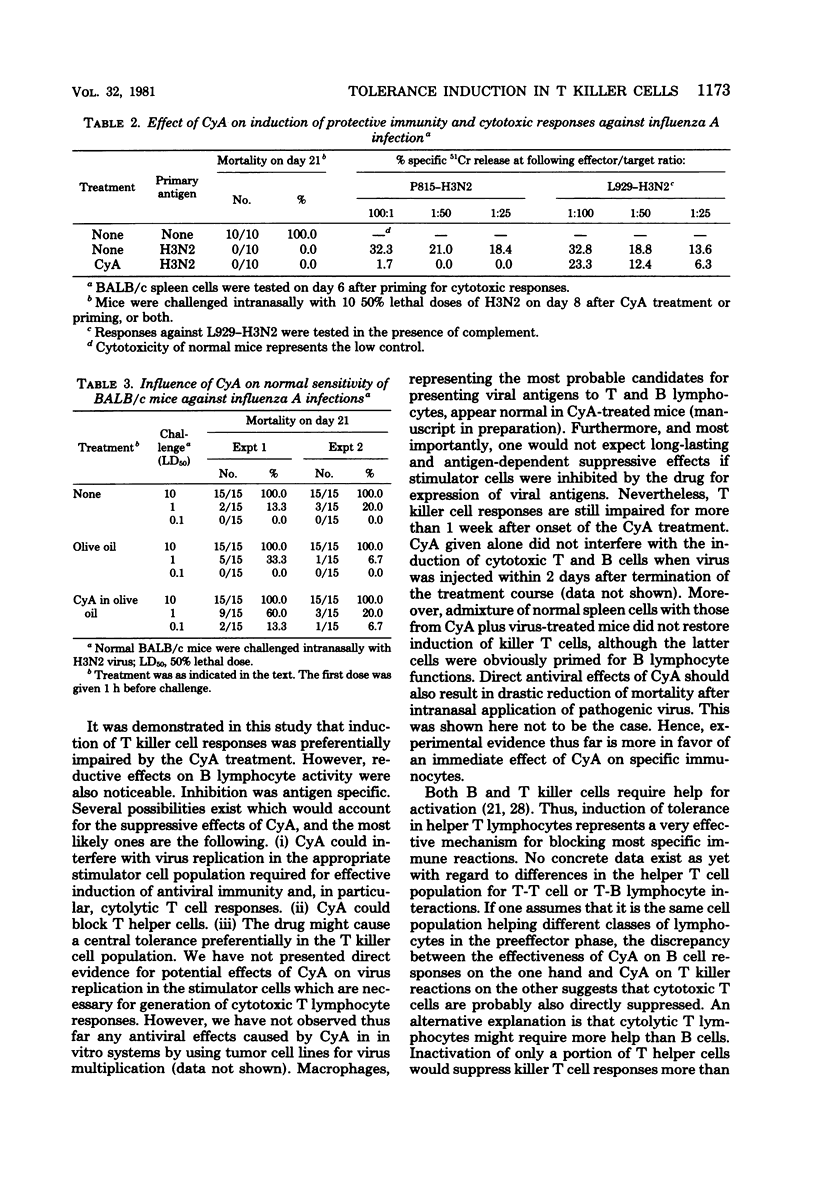
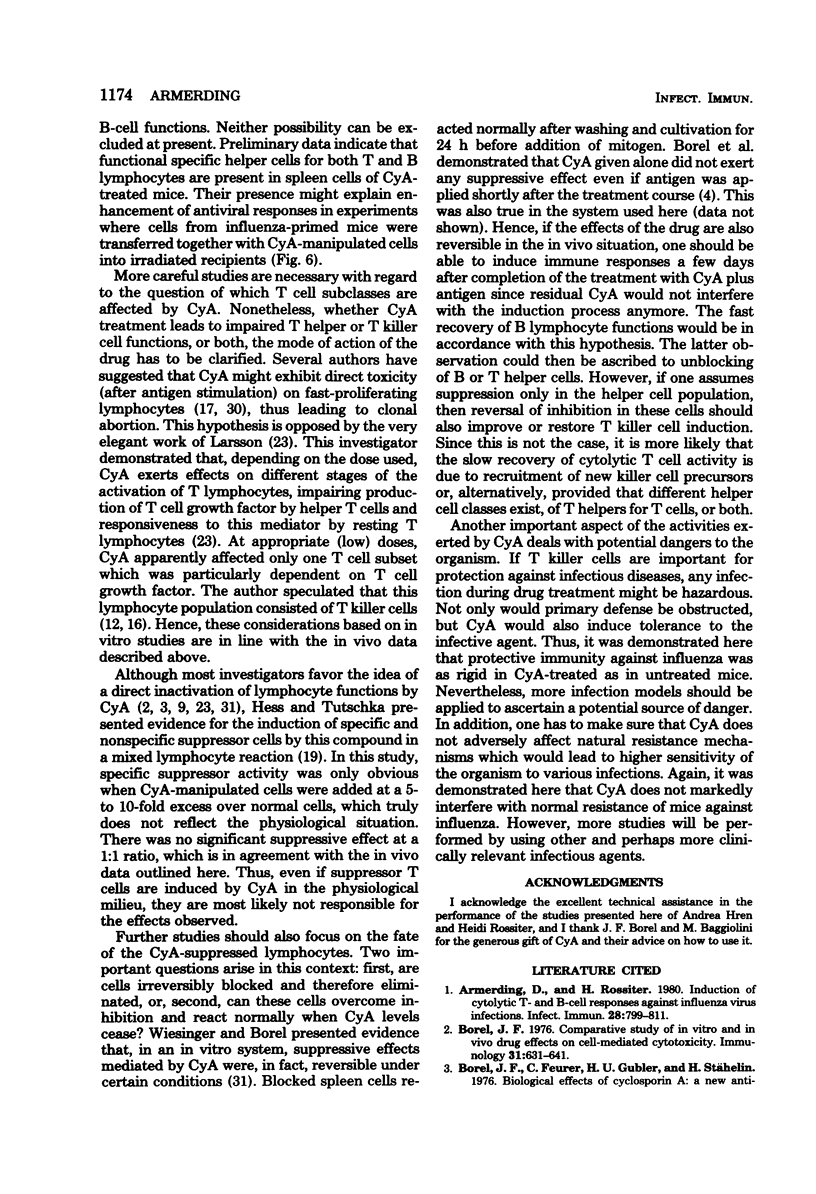

Selected References
These references are in PubMed. This may not be the complete list of references from this article.
- Armerding D., Rossiter H. Induction of cytolytic T- and B-cell responses against influenza virus infections. Infect Immun. 1980 Jun;28(3):799–811. doi: 10.1128/iai.28.3.799-811.1980. [DOI] [PMC free article] [PubMed] [Google Scholar]
- Borel J. F. Comparative study of in vitro and in vivo drug effects on cell-mediated cytotoxicity. Immunology. 1976 Oct;31(4):631–641. [PMC free article] [PubMed] [Google Scholar]
- Borel J. F., Feurer C., Magnée C., Stähelin H. Effects of the new anti-lymphocytic peptide cyclosporin A in animals. Immunology. 1977 Jun;32(6):1017–1025. [PMC free article] [PubMed] [Google Scholar]
- Braciale T. J. Immunologic recognition of influenza virus-infected cells. I. Generation of a virus-strain specific and a cross-reactive subpopulation of cytotoxic T cells in the response to type A influenza viruses of different subtypes. Cell Immunol. 1977 Oct;33(2):423–436. doi: 10.1016/0008-8749(77)90170-8. [DOI] [PubMed] [Google Scholar]
- Braciale T. J., Yap K. L. Role of viral infectivity in the induction of influenza virus-specific cytotoxic T cells. J Exp Med. 1978 Apr 1;147(4):1236–1252. doi: 10.1084/jem.147.4.1236. [DOI] [PMC free article] [PubMed] [Google Scholar]
- Brent L. Immunologic manipulation: specific mechanisms. Transplant Proc. 1979 Mar;11(1):839–844. [PubMed] [Google Scholar]
- Brunner K. T., Mauel J., Cerottini J. C., Chapuis B. Quantitative assay of the lytic action of immune lymphoid cells on 51-Cr-labelled allogeneic target cells in vitro; inhibition by isoantibody and by drugs. Immunology. 1968 Feb;14(2):181–196. [PMC free article] [PubMed] [Google Scholar]
- Burckhardt J. J., Guggenheim B. Cyclosporin A: in vivo and in vitro suppression of rat T-lymphocyte function. Immunology. 1979 Apr;36(4):753–757. [PMC free article] [PubMed] [Google Scholar]
- Calne R. Y. Immunosuppression for organ grafting -- observations on cyclosporin A. Immunol Rev. 1979;46:113–124. doi: 10.1111/j.1600-065x.1979.tb00286.x. [DOI] [PubMed] [Google Scholar]
- Coutinho A., Larsson E. L., Grönvik K. O., Andersson J. Studies on T lymphocyte activation II. The target cells for concanavalin A-induced growth factors. Eur J Immunol. 1979 Aug;9(8):587–592. doi: 10.1002/eji.1830090803. [DOI] [PubMed] [Google Scholar]
- Doherty P. C., Effros R. B., Bennink J. Heterogeneity of the cytotoxic response of thymus-derived lymphocytes after immunization with influenza viruses. Proc Natl Acad Sci U S A. 1977 Mar;74(3):1209–1213. doi: 10.1073/pnas.74.3.1209. [DOI] [PMC free article] [PubMed] [Google Scholar]
- Effros R. B., Doherty P. C., Gerhard W., Bennink J. Generation of both cross-reactive and virus-specific T-cell populations after immunization with serologically distinct influenza A viruses. J Exp Med. 1977 Mar 1;145(3):557–568. doi: 10.1084/jem.145.3.557. [DOI] [PMC free article] [PubMed] [Google Scholar]
- Gillis S., Smith K. A. Long term culture of tumour-specific cytotoxic T cells. Nature. 1977 Jul 14;268(5616):154–156. doi: 10.1038/268154a0. [DOI] [PubMed] [Google Scholar]
- Green C. J., Allison A. C. Extensive prolongation of rabbit kidney allograft survival after short-term cyclosporin-A treatment. Lancet. 1978 Jun 3;1(8075):1182–1183. doi: 10.1016/s0140-6736(78)90970-4. [DOI] [PubMed] [Google Scholar]
- Hasek M., Chutná J. Complexity of the state of immunological tolerance. Immunol Rev. 1979;46:3–26. doi: 10.1111/j.1600-065x.1979.tb00282.x. [DOI] [PubMed] [Google Scholar]
- Hess A. D., Tutschka P. J. Effect of cyclosporin A on human lymphocyte responses in vitro. I. CsA allows for the expression of alloantigen-activated suppressor cells while preferentially inhibiting the induction of cytolytic effector lymphocytes in MLR. J Immunol. 1980 Jun;124(6):2601–2608. [PubMed] [Google Scholar]
- Homan W. P., Fabre J. W., Williams K. A., Millard P. R., Morris P. J. Studies on the immunosuppressive properties of cyclosporin a in rats receiving renal allografts. Transplantation. 1980 May;29(5):361–366. doi: 10.1097/00007890-198005000-00003. [DOI] [PubMed] [Google Scholar]
- Katz D. H., Benacerraf B. The regulatory influence of activated T cells on B cell responses to antigen. Adv Immunol. 1972;15:1–94. doi: 10.1016/s0065-2776(08)60683-5. [DOI] [PubMed] [Google Scholar]
- Larsson E. L. Cyclosporin A and dexamethasone suppress T cell responses by selectively acting at distinct sites of the triggering process. J Immunol. 1980 Jun;124(6):2828–2833. [PubMed] [Google Scholar]
- Powles R. L., Barrett A. J., Clink H., Kay H. E., Sloane J., McElwain T. J. Cyclosporin A for the treatment of graft-versus-host disease in man. Lancet. 1978 Dec 23;2(8104-5):1327–1331. doi: 10.1016/s0140-6736(78)91971-2. [DOI] [PubMed] [Google Scholar]
- Stutman O., Shen F. W., Boyse E. A. Ly phenotype of T cells cytotoxic for syngeneic mouse mammary tumors: evidence for T cell interactions. Proc Natl Acad Sci U S A. 1977 Dec;74(12):5667–5671. doi: 10.1073/pnas.74.12.5667. [DOI] [PMC free article] [PubMed] [Google Scholar]
- White D. J., Calne R. Y., Plumb A. Mode of action of cyclosporin A: a new immunosuppressive agent. Transplant Proc. 1979 Mar;11(1):855–859. [PubMed] [Google Scholar]
- White D. J., Plumb A. M., Pawelec G., Brons G. Cyclosporin A: an immunosuppressive agent preferentially active against proliferating T cells. Transplantation. 1979 Jan;27(1):55–58. [PubMed] [Google Scholar]
- Wiesinger D., Borel J. F. Studies on the mechanism of action of cyclosporin A. Immunobiology. 1980 Jan;156(4-5):454–463. doi: 10.1016/S0171-2985(80)80078-7. [DOI] [PubMed] [Google Scholar]


